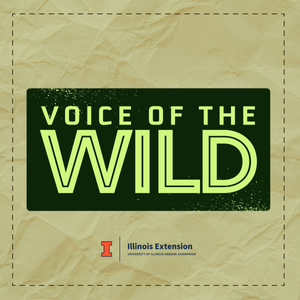
Voice of the Wild
University of Illinois Extension
All episodes
Best episodes
Top 10 Voice of the Wild Episodes
Goodpods has curated a list of the 10 best Voice of the Wild episodes, ranked by the number of listens and likes each episode have garnered from our listeners. If you are listening to Voice of the Wild for the first time, there's no better place to start than with one of these standout episodes. If you are a fan of the show, vote for your favorite Voice of the Wild episode by adding your comments to the episode page.
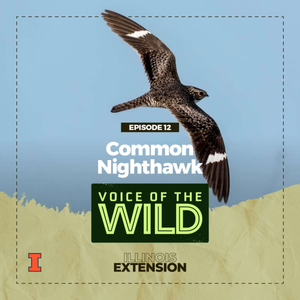
Episode 12: Common Nighthawk – Voice of the Wild
Voice of the Wild
07/05/24 • 1 min
Learn the song and call of the Common Nighthawk (Chordeiles minor).
The erratic flight and Narrow angular wings tipped with white bands give the common nighthawk a rather boomerang-like appearance. While it can be found foraging over its native habitats; marshes, ponds, and prairies, you’re more likely to hear its distinctive “peent” when heading downtown for a dinner with friends. That’s because this nightjar has an affinity for the evening city skyline. The bright city lights draw in plenty of insects for it to catch with its enormous mouth and it finds places to nest on the gravel roofs of apartments and hotels. This bird can make a booming sound with its wings, though this is far less commonly heard than its call.
Do you want to learn more bird songs, frog calls, and insect noises? Join Voice of the Wild every Friday to explore a new wild voice. From time to time, we’ll also do a deep dive into wildlife science, news, and natural history. Voice of the Wild is brought to you by the University of Illinois Extension Natural Resources, Environment, and Energy program.
Available on most podcast platforms, including Apple Podcasts, Spotify, and YouTube.
Subscription links Here
Subscribe to the Newsletter
Listen online on our Homepage
The following Cornell Lab | Macaulay Library recordings were used in this episode:
Common Nighthawk call by Geoffrey A. Keller (ML507144)
Common Nighthawk boom by Matthew D. Medler (ML507143)
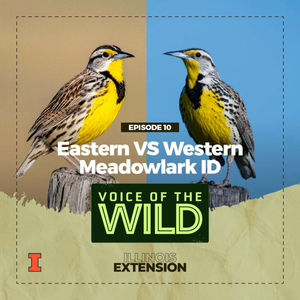
Episode 10: Eastern VS Western Meadowlark ID – Voice of the Wild
Voice of the Wild
06/21/24 • 2 min
Learn to tell the difference between Eastern and Western meadowlarks.
Both the Eastern meadowlark and Western meadowlark can be found in Illinois. The Western is only occasional in the state, while the Eastern is common throughout. Both species have a tawny back and yellow front with a black v on their chest, sing while perched on fences and powerlines, and fly with rapid wingbeats interrupted by periods of gliding. The visual differences between the two birds are very subtle. The western meadowlark has less white in its tail, less distinct markings on its head, and is paler on its sides, but these are variable traits and the most reliable way to tell the birds apart is by their voice. Luckily they're very vocal birds.
Do you want to learn more bird songs, frog calls, and insect noises? Join Voice of the Wild every Friday to explore a new wild voice. From time to time, we’ll also do a deep dive into wildlife science, news, and natural history. Voice of the Wild is brought to you by the University of Illinois Extension Natural Resources, Environment, and Energy program.
Available on most podcast platforms, including Apple Podcasts, Spotify, and YouTube.
Subscription links Here
Subscribe to the Newsletter
Listen online on our Homepage
The following Cornell Lab | Macaulay Library recordings were used in this episode:
Eastern Meadowlark song by Wil Hershberger (ML509953)
Eastern Meadowlark call by Ted Parker (ML509967)
Western Meadowlark song by Geoffrey A. Keller (ML509945)
Western Meadowlark call by Randolph Little (ML509951)
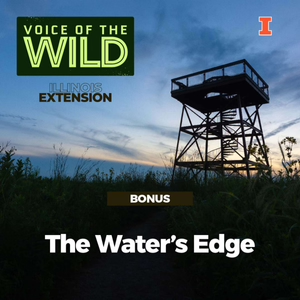
Bonus: The Water’s Edge – Voice of the Wild
Voice of the Wild
06/24/24 • 16 min
Headphones on! Today we’re giving voice to the array of plants and animals which can only be found where the land and the water mingle. It's a set of ecosystems united by inundation, whether it's the long edge of a shallow pond, a cypress swamp, or a wet prairie. It starts with an unwanted sparrow...
Thank you to the various researchers, friends, and coworkers who gave me feedback on this episode (and to my partner who listened to many drafts over the course of a weekend.)
This episode was written and recorded by Brodie Dunn. Some of the information from this recording was derived from a fantastic master naturalist training delivered by Dr. Susan McIntyre.
The following Cornell Lab | Macaulay Library recordings were used in this episode:
Dark-eyed Junco Song by Wil Hershberger (ML509729)
Henslow's Sparrow by Geoffrey A. Keller (ML509579)
Note: While I used this for emphasis at a few points, most Henslow’s calls in episode were native to the recordings.
Sora call by Geoffrey A. Keller (ML506061)
Virginia Rail grunt by Wil Hershberger (ML506054)
American Bittern booming song by Steven R. Pantle and Gregory Budney (ML505854)
Do you want to learn more bird songs, frog calls, and insect noises? Join Voice of the Wild every Friday to explore a new wild voice. From time to time, we’ll also do a deep dive into wildlife science, news, and natural history. Voice of the Wild is brought to you by the University of Illinois Extension Natural Resources, Environment, and Energy program.
Available on most podcast platforms, including Apple Podcasts, Spotify, and YouTube.
Subscription links Here
Subscribe to the Newsletter
Listen online on our Homepage
Voice of the Wild is a service of Illinois Extension’s Natural Resources, Environment, and Energy program.
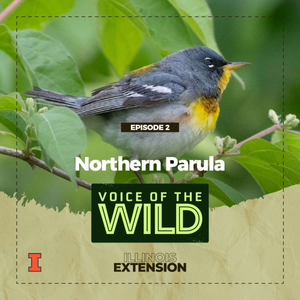
Episode 2: Northern Parula - Voice of the Wild
Voice of the Wild
05/03/24 • 1 min
Learn the song and call of the Northern Parula (Setophaga americana).
This bird forages at the top of the canopy so it can be hard to spot. Luckily, it's easy to hear. It calls with gusto, often ending an ascending trill with a loud hiccup. Getting a close look at the bird is worth the effort. It's among the most ostentatious of our migratory warblers: A blue head and back, bright wingbars, yellow under the bill, and a partial eyering that puts a white dot above and below each eye. Males even have a dark band across on their front, sometimes with a bit of orange in it. It's an absolute mess of color and a joy to behold.
Do you want to learn more bird songs, frog calls, and insect noises? Join Voice of the Wild every Friday to explore a new wild voice. From time to time, we’ll also do a deep dive into wildlife science, news, and natural history. Voice of the Wild is brought to you by the University of Illinois Extension Natural Resources, Environment, and Energy program.
Available on most podcast platforms, including Apple Podcasts, Spotify, and YouTube
Subscription links Here
Subscribe to the Newsletter
Voice of the Wild Homepage
The following Macaulay Library recordings were used in today’s episode:
ML509167 by Robert C. Stein and William W. H. Gunn, ML509169 by Gregory Budney, and ML509171 by Randolph Little and James Kimball
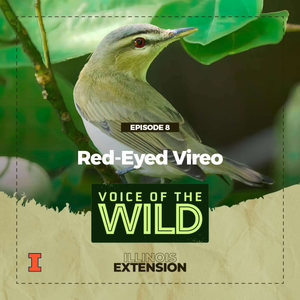
Episode 8: Red-Eyed Vireo – Voice of the Wild
Voice of the Wild
06/07/24 • 1 min
Learn the song and call of the Red-eyed vireo (Vireo olivaceus).
A key member of the summer orchestra, you’ll hear this common gray and olive bird on nearly every hike. It sings throughout the day, every day, seemingly every minute. Uttering short little phrases one after another as if it's just letting us know that it’s up there. It tends to slink about in the upper canopy inspecting the underside of leaves for caterpillars and other arthropods. Despite its name, its red iris is not always easy to see; look instead for its dark eyeline and pale eyebrow.
Do you want to learn more bird songs, frog calls, and insect noises? Join Voice of the Wild every Friday to explore a new wild voice. From time to time, we’ll also do a deep dive into wildlife science, news, and natural history. Voice of the Wild is brought to you by the University of Illinois Extension Natural Resources, Environment, and Energy program.
Available on most podcast platforms, including Apple Podcasts, Spotify, and YouTube.
Subscription links Here
Subscribe to the Newsletter
Listen online on our Homepage
The following Cornell Lab | Macaulay Library recordings were used in this episode:
Red-eyed vireo song (ML507846) by Geoffrey A. Keller
Red-eyed vireo call (ML507849) by Oliver H. Hewitt
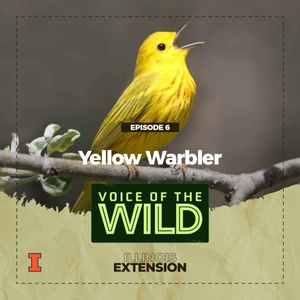
Episode 6: Yellow Warbler – Voice of the Wild
Voice of the Wild
05/24/24 • 1 min
Learn the song and call of the Yellow warbler (Setophaga petechia).
You might find this little yellow bird in a stand of willows next to a pond or hear its call while walking past the shrubby edge of a creek. Its song is an anthem of the early summer and it’s sung in two phrases. The first goes “sweet sweet sweet” and the second can be heard as “I’m so sweet” or “song so sweet.” The singer is yellow from head to tail with just a tinge of olive across its back. In the breeding season the males have handsome red streaks down their front.
Do you want to learn more bird songs, frog calls, and insect noises? Join Voice of the Wild every Friday to explore a new wild voice. From time to time, we’ll also do a deep dive into wildlife science, news, and natural history. Voice of the Wild is brought to you by the University of Illinois Extension Natural Resources, Environment, and Energy program.
Available on most podcast platforms, including Apple Podcasts, Spotify, and YouTube.
Subscription links Here
Subscribe to the Newsletter
Listen online on our Homepage
The following Macaulay Library recordings were used in this episode:
ML509228 by Mike Andersen, ML509226 by Wil Hershberger, and ML509234 Robert C. Stein
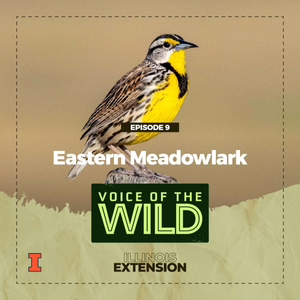
Episode 9: Eastern Meadowlark – Voice of the Wild
Voice of the Wild
06/14/24 • 2 min
Learn the song and call of the Eastern meadowlark (Sturnella magna).
This yellow-fronted bird with a black V on its chest often sings from fence posts and power lines. It’s fairly common anywhere grasses have been spared regular mowing. It nests on the ground where it forages for insects using a long pointed beak. When startled from its prairie or pasture home it flies away with rapid wingbeats then fans out its white-edged tail to catch the wind as it glides to a stop. Its call is harsh and electric but its song is sweet and smooth; the favorite of many farmers across the state.
Do you want to learn more bird songs, frog calls, and insect noises? Join Voice of the Wild every Friday to explore a new wild voice. From time to time, we’ll also do a deep dive into wildlife science, news, and natural history. Voice of the Wild is brought to you by the University of Illinois Extension Natural Resources, Environment, and Energy program.
Available on most podcast platforms, including Apple Podcasts, Spotify, and YouTube.
Subscription links Here
Subscribe to the Newsletter
Listen online on our Homepage
The following Cornell Lab | Macaulay Library recordings were used in this episode:
Eastern Meadowlark song by Wil Hershberger (ML509953)
Eastern Meadowlark call by Ted Parker (ML509967)

Episode 3: Palm Warbler - Voice of the Wild
Voice of the Wild
05/09/24 • 1 min
Learn the song and call of the Palm warbler (Setophaga palmarum).
It's easy to get a look at this warbler as it prefers to mingle in mixed flocks on the ground. You might mistake it for a sparrow at first, but it bobs its tail as it forages and it has yellow on its face and rump. In the spring adults have a chestnut-colored cap. This warbler sounds a little like a chipping sparrow but you can tell it's different because of how buzzy it is; it almost sounds digital.
Do you want to learn more bird songs, frog calls, and insect noises? Join Voice of the Wild every Friday to explore a new wild voice. From time to time, we’ll also do a deep dive into wildlife science, news, and natural history. Voice of the Wild is brought to you by the University of Illinois Extension Natural Resources, Environment, and Energy program.
Available on most podcast platforms, including Apple Podcasts, Spotify, and YouTube
Subscription links Here
Subscribe to the Newsletter
Voice of the Wild Homepage
The following Macaulay Library recordings were used in today’s episode:
ML509272 by Matthew D. Medler, ML509265 by Geoffrey A. Keller, and ML509268 by Linda Macaulay

Bonus: American Sycamore – Voice of the Wild
Voice of the Wild
05/13/24 • 7 min
Headphones on! In our first bonus episode we won’t be hearing an animal’s song and learning its voice. Instead, we’ll be giving voice to a tree. We’ll be hearing about Platanus occidentalis, the American Sycamore, and it starts with a walk through the woods...
Do you want to learn bird songs, frog calls, and insect noises? Join Voice of the Wild every Friday to explore a new wild voice. From time to time, we’ll also do a deep dive into wildlife science, news, and natural history. Voice of the Wild is brought to you by the University of Illinois Extension Natural Resources, Environment, and Energy program.
Available on most podcast platforms, including Apple Podcasts, Spotify, and YouTube.
Subscription links Here
Subscribe to the Newsletter
Listen online on our Homepage
This episode was written and recorded by Brodie Dunn.
The following Macaulay Library recordings were used in this episode:
Yellow-throated Warbler - ML509298 by Mike Andersen
Pine Sisken single call - ML510254 by Dave Herr
Pine Sisken flock - ML510252 by Geoffrey A. Keller
American Goldfinch call - ML510278 by Wil Hershberger
Great Blue Heron call - ML505864 by Randolph Little and James Kimball
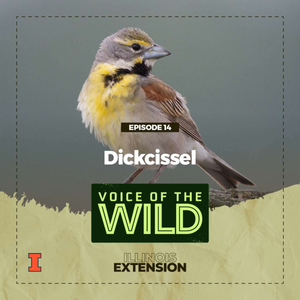
Episode 14: Dickcissel – Voice of the Wild
Voice of the Wild
07/19/24 • 2 min
Dickcissel (Spiza americana).
In a good tallgrass prairie the Dickcissel’s call can seem to come from every direction. It may have a passing resemblance to a Meadowlark, but on closer inspection you’ll find the Dickcissel is much smaller and has stubby finchlike beak. If you are still unsure, simply wait for the bird to sing it’s own name; dick-dick cissel-cissel.
Do you want to learn more bird songs, frog calls, and insect noises? Join Voice of the Wild every Friday to explore a new wild voice. From time to time, we’ll also do a deep dive into wildlife science, news, and natural history. Voice of the Wild is brought to you by the University of Illinois Extension Natural Resources, Environment, and Energy program.
Available on most podcast platforms, including Apple Podcasts, Spotify, and YouTube.
Subscription links Here
Subscribe to the Newsletter
Listen online on our Homepage
The following Cornell Lab | Macaulay Library recordings were used in this episode:
Dickcissel song by Geoffrey A. Keller (ML509877)
Dickcissel flight call by Paul Coopmans (ML509879)
Dickcissel call by Wil Hershberger (ML509878)
Sources and more:
- https://www.allaboutbirds.org/guide/Dickcissel/overview
- https://www.audubon.org/field-guide/bird/dickcissel
- Sibley, David. Sibley Birds East: Field Guide to Birds of Eastern North America. Second edition. New York: Alfred A. Knopf, 2016. Print.
- Peterson, Roger Tory, and Virginia Marie Peterson. A Field Guide to the Birds: A Completely New Guide to All the Birds of Eastern and Central North America. Fourth edition, completely revised and enlarged. Boston: Houghton Mifflin Company, 1980. Print.
- Dobson, Colin et al. Field Guide to Hotspots and Birds in Illinois. Champaign-Urbana: Scissortail LLC, 2023. Print.
- Godfrey, Michael A, John Farrand, and Roger Tory Peterson. Videoguide to the Birds of North America. New York, N.Y: MasterVision, 1985. Film.
Show more best episodes

Show more best episodes
FAQ
How many episodes does Voice of the Wild have?
Voice of the Wild currently has 36 episodes available.
What topics does Voice of the Wild cover?
The podcast is about Nature, Outdoors, Wildlife, Podcasts, Education, Birds and Birding.
What is the most popular episode on Voice of the Wild?
The episode title 'Episode 10: Eastern VS Western Meadowlark ID – Voice of the Wild' is the most popular.
What is the average episode length on Voice of the Wild?
The average episode length on Voice of the Wild is 3 minutes.
How often are episodes of Voice of the Wild released?
Episodes of Voice of the Wild are typically released every 7 days.
When was the first episode of Voice of the Wild?
The first episode of Voice of the Wild was released on Apr 16, 2024.
Show more FAQ

Show more FAQ